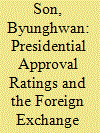|
|
|
Sort Order |
|
|
|
Items / Page
|
|
|
|
|
|
|
| Srl | Item |
| 1 |
ID:
100261


|
|
|
|
|
| Publication |
2010.
|
| Summary/Abstract |
This paper tests the volatility spillovers between the Shanghai market and the main developed stock markets abroad, namely New York, Tokyo, London, and Frankfurt, as well as between the Shanghai market and the emerging stock markets, namely Hong Kong, and Korea. The tests cover the period of 11 July 2005-12 July 2007 and 1 August 2007-10 July 2009, since the financial crisis started from July 2007. To account for asymmetries in the volatility transmission mechanism, we have used the GARCH and EGARCH model. The main findings are as follows. First, the degree of the Leverage Effect of the Shanghai market changes in the opposite direction from most of the other sample markets after the financial crisis began in July 2007. This change implies that investors in the Shanghai markets began to pay close attention to bad news. Secondly, reciprocal spillovers exist for some market pairs before the crisis, as the Shanghai A-share market has unidirectional influence on the emerging markets. After the onset of the financial crisis, the stock markets in developed countries have bidirectional influences on each other. The financial crisis brings the developed markets closer together than before, but they do not receive volatility spillover from the Shanghai A-share market. The financial crisis also influences the Asian emerging markets so as to decrease the volatility transmission that comes from the Shanghai A-share market. The Chinese mainland market is still not a vital security market in the world, although it has become the third largest one. Thirdly, the risk-precautionary role of the Shanghai B-share market is not as significant as expected.
|
|
|
|
|
|
|
|
|
|
|
|
|
|
|
|
| 2 |
ID:
163505


|
|
|
|
|
| Summary/Abstract |
The framework of “one currency, two markets” makes China’s currency market quite unique compared to its Western counterparts. In this study, we characterize the linkage between the onshore and offshore Renminbi exchange rates, and estimate the effect of the recent Renminbi market reforms against the backdrop of Renminbi internationalization. Using GARCH-type models, we find robust evidence of the volatility clustering phenomenon and the leverage effect in the pricing differential between the onshore and offshore exchange rates. We also find that the recent Renminbi currency market reforms all increase the volatility of the pricing differential between the two Renminbi markets, while these reforms are proved to either enlarge or shrink the pricing differential.
|
|
|
|
|
|
|
|
|
|
|
|
|
|
|
|
| 3 |
ID:
132659


|
|
|
|
|
| Publication |
2014.
|
| Summary/Abstract |
We apply a recently developed unit root test that simultaneously accounts for heteroskedasticity and structural breaks to United States monthly natural gas consumption. We find that United States monthly natural gas consumption is stationary. Our results illustrate the importance of accounting for heteroskedasticity when testing for a unit root in energy consumption with higher frequency data.
|
|
|
|
|
|
|
|
|
|
|
|
|
|
|
|
| 4 |
ID:
184052


|
|
|
|
|
| Summary/Abstract |
Are price discontinuities in cryptocurrencies jointly related to large swings in geopolitical risk? This is a relevant question to answer given recent news from the press that Bitcoin’s price jumps are driven by jumps in the level of geopolitical risk index. To answer this question, we examine first the jump incidence of daily returns for Bitcoin and other leading cryptocurrencies and then study the co-jumps between cryptocurrencies and the geopolitical risk index using logistic regressions. Our dataset is at the daily frequency and covers the period 30 April 2013 to 31 October 2019. The results show that the price behaviour of all cryptocurrencies under study is jumpy but only Bitcoin jumps are dependent on jumps in the geopolitical risk index. This revealed evidence of significant co-jumps for the case of Bitcoin only nicely complements previous studies arguing that Bitcoin is a hedge against geopolitical risk.
|
|
|
|
|
|
|
|
|
|
|
|
|
|
|
|
| 5 |
ID:
181395


|
|
|
|
|
| Summary/Abstract |
Do presidential approval ratings affect exchange rates? The empirical purview of the vast literature on this topic has been confined to the run-up to elections. The importance of approval ratings in non-election periods has therefore been under-studied. Examining daily data on the exchange rate of the Korean won during the presidency of Park Geun Hye, we find that the won weakened (1) when Park’s ratings were low and (2) when they bounced back unexpectedly from a low level. This finding explains why Park’s impeachment did not lead to a serious panic in the won market. It seems that well before the impeachment, the exchange rate already reflected the market’s concerns about the uncertainty in the government.
|
|
|
|
|
|
|
|
|
|
|
|
|
|
|
|
| 6 |
ID:
097199


|
|
|
|
|
| Publication |
2010.
|
| Summary/Abstract |
This paper examines the impacts of world, country, and sector-specific variables on the stock return volatility of twenty-seven US sectors in the short- and long-run, accounting for the asymmetric shocks based on GARCH models. In the standard GARCH model the two world variables, oil and Morgan Stanley Capital Index (MSCI), have differing impacts on the US equity sector returns' volatility, with oil price dampening it while MSCI heightening it for most sectors. This result underlines the need for hedging more against world capital market risk relative to oil risk which is probably hedged by many sectors. The world and country factors' impacts are not as pervasive across the board, compared with the sector-specific impacts of the P/B ratio and trading volume which affect almost all sectors. Increases in the P/B ratio would reduce the aggregate volatility, while increases in the trading volume would heighten it for all sectors. Asymmetry of factor impacts on volatility is also found for most sectors. Most of the GARCH factor results are confirmed in the CGARCH model with the exception of the impact of interest rate on the short-lived transitory volatility. Finally, interesting econometric results on the inclusion or exclusion of trading volumes are discussed.
|
|
|
|
|
|
|
|
|
|
|
|
|
|
|
|
|
|
|
|
|